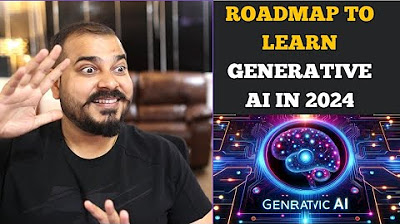How to learn Machine Learning (ML/AI Roadmap 2024)
Summary
TLDRIn this machine learning course introduction, Kylie Ying outlines a roadmap for effectively learning the field. She emphasizes the importance of foundational math, including probability, statistics, calculus, and linear algebra, as well as programming skills, particularly in Python. The course covers core machine learning concepts, types of learning, and数据处理. It also touches on various models like neural networks and CNNs, and concludes with the necessity of practice, research, and community engagement for expertise.
Takeaways
- 📚 Start with a strong foundation in basic math, including probability and statistics, calculus, and linear algebra, to understand the theory behind machine learning.
- 🧠 Probability and statistics are essential for making predictions and understanding the most probable outcomes in machine learning.
- 🔍 Learn about concepts like conditional probability, Bayes' Rule, and statistical distributions to model the unpredictable world effectively.
- 📈 Calculus, particularly optimization problems and gradient descent, is vital for training models in machine learning.
- 📉 Derivatives play a crucial role in adjusting parameters to achieve desired outcomes in machine learning models.
- 🔡 Linear algebra is key for handling large-scale data computations and operations in machine learning.
- 🤖 Programming skills, especially in Python, are necessary for implementing machine learning models.
- 🐍 Python is favored for machine learning due to its popularity, extensive documentation, and rich library ecosystem.
- 🔧 Understand programming concepts such as variables, functions, classes, and how to utilize libraries like pandas, numpy, and machine learning frameworks.
- 🌟 Explore core machine learning concepts including types of machine learning (supervised, unsupervised, reinforcement), tasks (classification, regression), and models (KNN, logistic regression, SVM, etc.).
- 🔧 Data is crucial in machine learning; understand data types, the importance of training, validation, and testing datasets, and data manipulation techniques like cleaning, scaling, and feature engineering.
- 👨🏫 Practice and research are key to deepening expertise in machine learning; engage with projects, datasets, and communities like Kaggle, and read research papers to stay updated.
Q & A
What is the primary focus of Kylie Ying's machine learning course?
-The primary focus of Kylie Ying's machine learning course is to teach students how to learn machine learning effectively by providing a roadmap that covers concepts from the fundamentals to becoming an expert in the field.
Why is foundational math important in machine learning?
-Foundational math is important in machine learning because it provides the necessary understanding of probability, statistics, calculus, and linear algebra, which are essential for modeling and predicting outcomes in the unpredictable world.
What are the two main areas of mathematics that Kylie Ying emphasizes as foundational for machine learning?
-The two main areas of mathematics emphasized are probability and statistics, and calculus. These areas are crucial for understanding predictions, optimization problems, and the behavior of machine learning models.
How does the Brilliant platform help in learning foundational math for machine learning?
-The Brilliant platform helps by offering thousands of interactive lessons that allow learners to gain an intuition in different areas of math, data analysis, programming, and AI, focusing on hands-on problem-solving and critical thinking skills.
What programming language does Kylie Ying recommend for beginners in machine learning?
-Kylie Ying recommends Python for beginners in machine learning due to its popularity, extensive documentation, supportive resources, and great libraries for processing data and working with models.
Why is Python considered a good starting point for learning machine learning?
-Python is considered a good starting point because it is widely used in the machine learning community, has a vast ecosystem of libraries, and is beginner-friendly, making it easier to prototype and experiment with machine learning models.
What are the core concepts Kylie Ying mentions in the machine learning roadmap?
-The core concepts mentioned include understanding what machine learning is, types of machine learning, tasks such as classification and regression, the importance of data, data manipulation techniques, various machine learning models, neural networks, and training and evaluating models.
What is the significance of understanding data types and data manipulation in machine learning?
-Understanding data types and manipulation is significant because it impacts the quality and relevance of the data fed into machine learning models. Good data practices ensure that the models are trained effectively and produce accurate predictions.
What are some of the machine learning models Kylie Ying lists in the script?
-Some of the machine learning models listed include K-nearest neighbors, logistic regression, support vector machines (SVM), linear regression, neural networks, convolutional neural networks (CNN), recurrent neural networks (RNN), GRUs, LSTMs, and principal component analysis (PCA).
How does Kylie Ying suggest one becomes an expert in machine learning?
-Kylie Ying suggests that becoming an expert in machine learning involves a combination of practice, research, and learning from experts. This includes working on projects, using resources like the UCI machine learning repository and Kaggle, reading papers, and implementing the findings to gain deep expertise in a chosen area.
Outlines

This section is available to paid users only. Please upgrade to access this part.
Upgrade NowMindmap

This section is available to paid users only. Please upgrade to access this part.
Upgrade NowKeywords

This section is available to paid users only. Please upgrade to access this part.
Upgrade NowHighlights

This section is available to paid users only. Please upgrade to access this part.
Upgrade NowTranscripts

This section is available to paid users only. Please upgrade to access this part.
Upgrade NowBrowse More Related Video

Introduction to Machine Learning Completed

Week 1 - Lecture 1 - Introduction to Machine Learning

How to Become a Data Scientist in 2024? (complete roadmap)

Roadmap to Learn Generative AI(LLM's) In 2024 With Free Videos And Materials- Krish Naik

How I'd Learn AI (If I Had to Start Over)

AI Engineer : The ULTIMATE Roadmap for 2024
5.0 / 5 (0 votes)